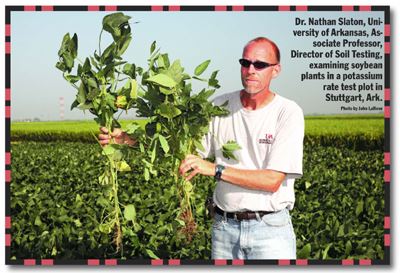The Fine Tuning Of Soil Recommendations
FAYETTEVILLE, ARK.
Boron fertilization of soybeans and phosphorous and potassium fertilization of soybeans are two topics the University of Arkansas is taking a closer look at.
Dr. Nathan Slaton, Associate Professor and Director of soil testing at the University of Arkansas, is continuing his research on boron fertilization of soybeans. “Boron deficiency continues to be a problem primarily on the silt loam soils west of Crowley’s Ridge in Northeast Arkansas,” he said.
“The phosphorous and potassium research is aimed at improving soil test recommendations,” said Slaton. “We are trying to improve our ability to identify soils that need potassium and phosphorous via soil testing and from that information tell the farmer the exact rates of P and K that he needs, not only to maximize yields for that current crop but also to sustain that soil productivity over time.”

Soil testing has been around for a long time but yield increases have changed. “One thing that changes is that crop yields, over the past 50 years that soil testing has existed, yields have continued to increase.” Production of high crop yields increases the demands on soil fertility by increasing nutrient removal which relates to the amount of nutrients that we have to add to keep up with that nutrient removal change,” explained Slaton.
“Not only have our yields changed but some of our production systems have also changed,” he said. Slaton explained one of the shifts in soybeans has been from group 5 beans to group 4’s. “While some guys are growing group 3’s, the question is do they respond the same because they may be planted earlier.” Other issues that need to be looked at are drilled, wide rows or bed planting and plant population according to Slaton.
“Technology that we use in soil testing, changes in instrumentation as well as methodologies need to be revisited and re-correlated,” said Slaton. Slaton has been conducting research at different sites such as Stuttgart and Pine Tree, Arkansas. One study has been going on for eight years. The longer term studies, said Slaton, “allows us to look at fertilization practices for more than one year and see how crop yields respond across time to different P and K rates.”
“In the long term studies we are trying to verify that our recommended potassium rate is not just adequate for this year’s crop but is adequate over several years to maintain yield potential and soil productivity,” said Slaton. A complete summary of Slaton’s past four years of potassium research appears in Better Crops, Vol. 91, 2007, No. 2. Δ